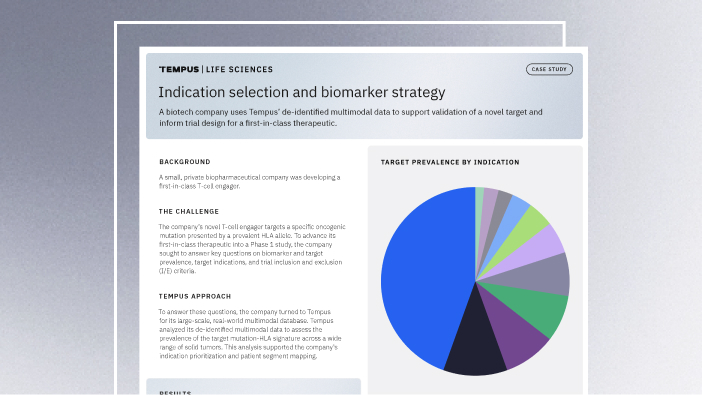-
PROVIDERS
New MRD Medicare Coverage for Select Indications*
*When coverage criteria are met. Additional criteria and exceptions for coverage may apply.
-
LIFE SCIENCES
ENROLL NOW
Tempus’ patient-derived organoid screens
Evaluate the efficacy of your preclinical compounds using fixed organoid panels designed for diverse therapeutic applications -
PATIENTS
It's About Time
View the Tempus vision.
- RESOURCES
-
ABOUT US
View Job Postings
We’re looking for people who can change the world.
- INVESTORS
05/01/2025
Q&A: Connecting real-world data and organoids through Tempus Loop
Tim Hagerty, Ph.D, VP, Life Science Strategy at Tempus, discusses Tempus Loop, a platform aimed at enhancing target identification and validation by connecting real-world data with patient-derived organoids. He explains how this integrated approach overcomes limitations in traditional methods and its potential to accelerate preclinical development in oncology.
Authors
Tim Hagerty, Ph.D
Vice President, Life Science Strategy, Tempus

Vice President, Life Science Strategy, Tempus

Could you tell us about your experience at Tempus and your role in the development of Tempus Loop? |
Hagerty, Ph.D: After spending over 20 years working in the pharmaceutical and biotech industries, I joined Tempus as the Vice President of Life Science Strategy, supporting the development of collaborative relationships with our partner companies. In this role, I also lead the strategy of Tempus Loop, with the leadership of Justin Guinney, SVP Genomics, and Richard Klinghoffer, SVP of Systems Biology. |
What is Tempus Loop, and what is its primary purpose in the context of oncology research and development? |
Hagerty, Ph.D: Simply put, Tempus Loop is a platform combining real-world data (RWD) and patient-derived organoids (PDOs) to accelerate target identification and validation. We leverage our de-identified, multimodal data, enhanced with AI and external datasets, to identify candidate targets. These targets are then tested using our PDO models, which utilize the same next-generation sequencing tests—Tempus xT (DNA-seq) and Tempus xR (RNA-seq)—as our RWD, ensuring validation. Finally, we ‘loop’ back into our RWD to show the current treatment and cohort characteristics of patients who may benefit from these validated targets. |
Can you explain the key components of Tempus Loop and how they’re integrated to form the platform? |
Hagerty, Ph.D: We marry our AI-enabled RWD platform containing DNA, RNA, single-cell RNA-seq, spatial data, clinical data, knowledge graphs, and histopathology data with public datasets to identify multimodal cohorts and enable target identification through network mapping within a systems biology approach. We can then overlay these insights onto our extensive PDO models to validate our potential targets through various methods, including CRISPR knockdown screening and Perturb-seq. |
What challenges in target identification and validation led to the development of Tempus Loop? How does it address these challenges? |
Hagerty, Ph.D: Tempus Loop addresses two key challenges within target discovery. The first is access to a large collection of multimodal RWD, an area where Tempus is unparalleled. We can mine real-world patient data and align target discovery with true unmet patient needs. Data is key.The second challenge is the fragmented nature of many drug discovery efforts, where teams often operate in silos and the steps from target identification to validation lack true continuity. Tempus Loop helps bridge this gap by creating a more integrated workflow. |
|
“Tempus Loop helps bridge this gap by creating a more integrated workflow.” – Tim Hagerty, Vice President of Life Science Strategy, Tempus |
How does the integration of multimodal RWD enhance the analytical power of Tempus Loop? |
Hagerty, Ph.D: By combining our RWD with our modeling lab capabilities, Tempus Loop creates a unified approach that enables a ‘loop’, and an interactive hypothesis and validation engine, where drug discovery can enter at any point in this cycle. |
What role do PDOs play in the target validation process within Tempus Loop? |
Hagerty, Ph.D: Two key differentiators within our PDO models further the target validation process: 1) the PDOs are extensive and well-characterized, and 2) this characterization is aligned with how we integrate our multimodal clinical records. More importantly, we use the same xT and xR assays in both the organoids and within our RWD, which enhances the translation from bench to bedside. |
How do AI and machine learning (ML) contribute to the target identification and validation process in Tempus Loop? |
Hagerty, Ph.D: Our target discovery platform leverages advanced AI and ML techniques to enhance the identification and validation of gene targets associated with patient response. By training models with our extensive patient RWD, we can fine-tune transformer models to help pinpoint gene targets that correlate with therapeutic outcomes. Additionally, ML is instrumental in developing molecular classifiers that map PDO samples to patient molecular subtypes.Furthermore, ML models are employed to identify gene targets associated with patient response and molecular subtypes. These models enable us to rank these targets for functional validation in PDO screens based on the important features identified by the models. This process ensures that the most promising gene targets are prioritized for further investigation. |
How does Tempus Loop help ensure the accuracy and reliability of the data and insights it provides? |
Hagerty, Ph.D: This is the beauty of Tempus Loop: we use our RWD to generate the potential targets, then we can test these within our PDOs, and then bring this back into the observed patient cohorts. Due to the breadth of our PDOs, we can map our subtypes to specific PDOs and identify control PDOs that do not have the same characteristics. Our CRISPR-based high-throughput screening allows for a quick assessment to determine potential candidates, which are then further assessed against control clusters and known oncogenic drivers. |
What value does Tempus Loop bring to life science researchers and the broader scientific community? |
Hagerty, Ph.D: First, speed. The integration of these approaches allows target identification and validation to occur more seamlessly, which can reduce the cycle time by half. Moreover, the ability to test further hypotheses against our multimodal patient data helps ensure that the targets identified and validated are more strongly linked to real-world clinical context. |
Can you provide examples of how Tempus Loop has accelerated preclinical development in oncology research? |
Hagerty, Ph.D: There are two recent examples that best illustrate the potential of Tempus Loop. The first used an unsupervised clustering approach to identify potential targets in NSCLC, which uncovered a novel patient cluster with a significant patient population and a high unmet clinical need. Leveraging our PDO biobank, we were able to quickly screen and validate these potential targets to narrow down a selection of targets that are unique and relevant for potential therapeutics.The second example used a different entry point within our Tempus Loop process. In this case, we leveraged our pan-cancer PDO screening, testing standard-of-care, commercialized antibody-drug conjugates (ADCs), and their respective payloads across a range of PDOs. We tested enfortumab vedotin across these PDOs and created a unique gene signature correlating Nectin-4 expression to the response. We then brought this gene signature into our RWD and identified a cluster of patients who exhibited it. When compared to clinically treated patients without the gene signature, there was a significant difference in survival. In this example, we started with PDOs and carried the insights into the patient data, showing the translatability of our models. |
What excites you the most about the future of Tempus Loop and its potential in advancing personalized cancer therapeutics? |
Hagerty, Ph.D: As the next era of precision medicine continues to unfold, patient identification by a single protein expression may no longer be sufficient. The complexity of the disease and the impressive ability of cancer cells to adapt through the patient journey require a cohesive approach to target discovery and validation that addresses what is seen in the real-world patient populations. |
If you could highlight one key takeaway for researchers considering using Tempus Loop, what would it be? |
Hagerty, Ph.D: Relevance. We use patient data to drive the insights that are validated through the same characterization in our modeling lab, unifying target discovery and validation. |
To learn more about Tempus Loop, click here or contact us.
-
12/11/2025
Driving enterprise value with RWD
Hear from biotech CEOs and VC leaders as they discuss how real-world data can inform strategic decision-making in biotech companies.
Watch replay -
11/11/2025
A new era of biopharma R&D: The TechBio revolution—realities and the next frontier
Join Tempus and Recursion leaders to explore their strategic TechBio partnership. Learn how they use AI and supercomputing with petabytes of data to accelerate drug discovery and development. See the impact on biopharma R&D's future.
Watch replay -
11/14/2025
Validating a novel target and informing trial design for a first-in-class therapeutic
Discover how a biopharma company used Tempus’ de-identified multimodal data to support validation of a novel target and inform trial design for a first-in-class therapeutic.
Read more


